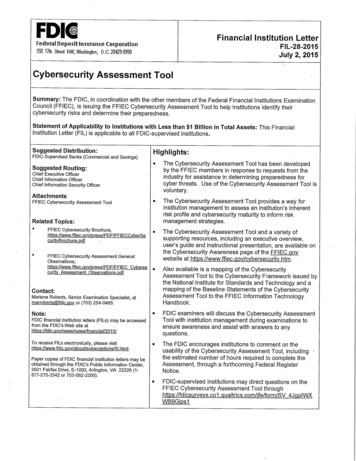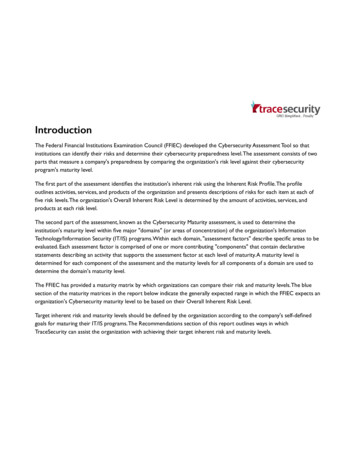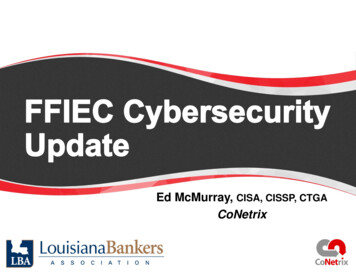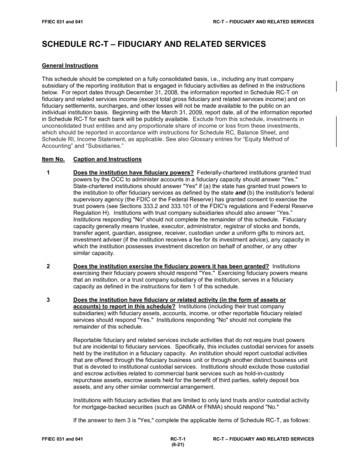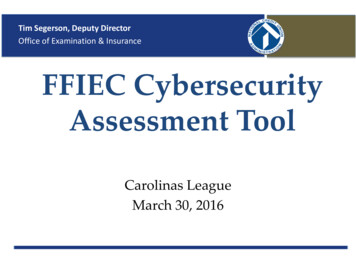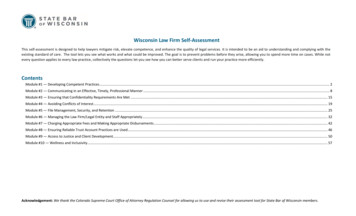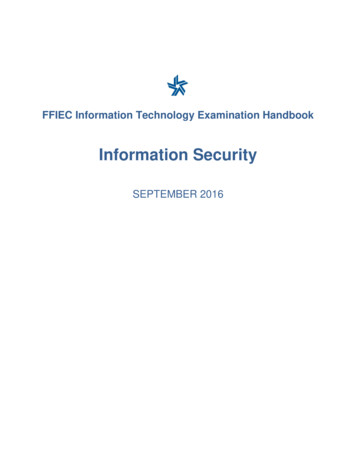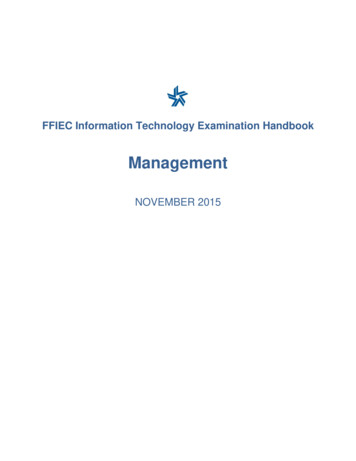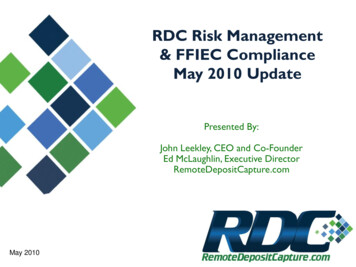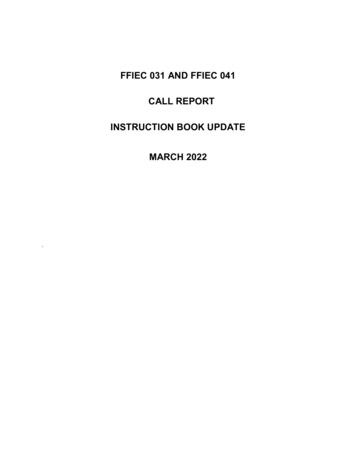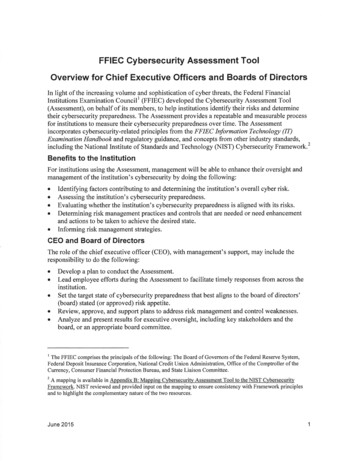
Transcription
FFIEC Gybersecurity Assessment ToolOverview for Chief Executive Officers and Boards of DirectorsIn light of the increasing volume and sophistication of cyber threats, the Federal FinancialInstitutions Examination Councilr (FFIEC) developed the Cybersecurity Assessment Tool(Assessment), on behalf of its members, to help institutions identify their risks and determinetheir cybersecurity preparedness. The Assessment provides a repeatable and measurable processfor institutions to measure their cybersecurity preparedness over time. The Assessmentincorporates cybersecurity-related principles from the FFIEC Information Technologt (IT)Examination Hqndbook and regulatory guidance, and concepts from other industry standards,including the National Institute of Standards and Technotogy NfSf) Cybersecurity Framework.2Benefits to the lnstitutionFor institutions using the Assessment, management will be able to enhance their oversight andmanagement of the institution's cybersecurity by doing the following:oooooIdentifying factors contributing to and determining the institution's overall cyber risk.Assessing the institution's cybersecuritypreparedness.Evaluating whether the institution's cybersecurity preparedness is aligned with its risks.Determining risk management practices and controls that are needed or need enhancementand actions to be taken to achieve the desired state.Informing risk management strategies.CEO and Board of DirectorsThe role of the chief executive officer (CEO), with management's support, may include theresponsibility to do the following:¡oo¡.Develop a plan to conduct the Assessment.Lead employee efforts during the Assessment to facilitate timely responses from across theinstitution.Set the target state ofcybersecurity preparedness that best aligns to the board ofdirectors'(board) stated (or approved) risk appetite.Review, approve, and support plans to address risk management and control weaknesses.Analyze and present results for executive oversight, including key stakeholders and theboard, or an appropriate board committee.' The FFEC comprises the principals of the following: The Board of Govemors of the Federal Reserve System,Federal Deposit Insurance Corporation, National Credit Union Administration, Office of the Comptroller of theCurrency, Consumer Financial Protection Bureau, and State Liaison Committee.2A mapping is available inFramework. NIST reviewed and provided input on the mapping to enswe consistency with Framework principlesand to highlight the complementary nature of the two resources.June 201 51
* ,r,-a Cybersecurity Assessment roolo Oversee the performance of ongoing monitoringoOverview for CEOs and Boards of Directorsto remain nimble and agile in addressingevolving areas of cybersecurity risk.Oversee changes to maintain or increase the desired cybersecurity preparedness.The role of the board, or an appropriate board committee, may include the responsibilþ to dothe following:o.oo.oEngage management in establishing the institution's vision, risk appetite, and overallstrategic direction.Approve plans to use the Assessment.Review management's analysis of the Assessment results, inclusive of any reviews oropinions on the results issued by independent risk management or internal audit functionsregarding those results.Review management's determination of whether the institution's cybersecurity preparednessis aligned with its risks.Review and approve plans to address any risk management or control weaknesses.Review the results of management's ongoing monitoring of the institution's exposure to andpreparedness for cyber threats.Assessment's Parts and ProcessThe Assessment consists of two parts: Inherent Risk Profile and Cybersecurity Maturity. Uponcompletion of both parts, management can evaluate whether the institution's inherent risk andpreparedness are aligned.Inherent Risk ProfileCybersecurity inherent risk is the level of risk posed to the institution by the following:oooooTechnologies and Connection TypesDelivery ChannelsOnline/lVlobile Products and Technology ServicesOrganizational CharacteristicsExternal ThreatsInherent risk incorporates the type, volume, and complexity of the institution's operations andthreats directed at the institution. Inherent risk does not include mitigating controls. The InherentRisk Profile includes descriptions of activities across risk categories with definitions for the leastto most levels of inherent risk. The profile helps management determine exposure to risk that theinstitution's activities, services, and products individually and collectively pose to the institution.LeastMinimalModerateSignificantMost lnherentInherent Risklnherent Risklnherent Risklnherent RìskRiskWhen each of the activities, services, and products are assessed, management can review theresults and determine the institution's overall inherent risk profile.June 201 52
' ,r,ra Cybersecurity Assessment ToolOverview for CEOs and Boards of DirectorsCybersecurity MaturityThe Assessment's second part is Cybersecurity Maturity, designed to help management measurethe institution's level of risk and corresponding controls. The levels range from baseline toinnovative. Cybersecurþ Maturity includesstatements to determine whether an instifution'slnnovativebehaviors, practices, and processes can supportcybersecurity preparedne s s within the followingAdvancedfive domains:.o.o.Cyber Risk Management and OversightThreat Intelligence and CollaborationCybersecurityControlsExtemal Dependency ManagementCyber Incident Management and ResilienceBaselineThe domains include assessment faitors andcontributing components. Within eachcomponent, declarative statements describeactivities supporting the assessment factor at eachmaturity level. Management determines which declarative statements best fit the currentpractices of the institution. All declarative støtements ín each maturíty level, and previouslevels, musl be attaíned ønd sustained to øchíeve thot domaín's maturíty level. Whilemanagement can determine the institution's maturþ level in each domain, the Assessment is notdesigned to identify an overall cybersecurity maturity level. The figure below provides the fivedomains and assessment factors.Domain 1: CyberRrsk Management& OversightDomain 2 Threattntelligence &CollaborationDomain 3:CybersecurityControlsDomain ntMonitoring in 5: CyberfncÌdent Managemenland ResiliencelncidentResiliencePlanning andStrategyDetection,Response, andMitigationEscalation andReportingTraining andCultureJune 20153
ft ,r,-"Cybersecurity Assessment TootOverview for CEOs and Boards of DirectorsManagement can review the institution's Inherent Risk Profile in relation to its CybersecurityMaturity results for each domain to understand whether they are aligned. The following tabledepicts the relationship between an institution's Inherent Risk Prof,rle and its domain MaturityLevels, as there is no single expected level for an institution. In general, as inherent risk rises, aninstitution's maturity levels should increase. An institution's inherent risk profile and maturitylevels will change over time as threats, vulnerabilities, and operational environments change.Thus, management should consider reevaluating the institution's inherent risk profile andcybersecurity maturity periodically and when planned changes can affect its inherent risk prof,rle(e.g., launching new products or services, new connections).RisUMaturiÇInherent Risk LevelsRelationship- Loc(!f (Jc, EoOJ og d,Ë-o! rÉc,a!oGu¡ Management can then decide what actions are needed either to affect the inherent risk profile orto achieve a desired state of maturity. On an ongoing basis, management may use theAssessment to identiff changes to the institution's inherent risk profile when new threats arise orwhen considering changes to the business strategy, such as expanding operations, offering newproducts and services, or entering into new third-party relationships that support criticalactivities. Consequently, management can determine whether additional risk managementpractices or controls are needed to maint¿in or augment the institution's cybersecurity maturity.Supporti ng lm plementat¡onAn essential part of implementing theAssessment is to validate the institution'sprocess and findings and the effectiveness andsufficiency of the plans to address anyidentified weaknesses. The next sectionprovides some questions to assist managementand the board when using the Assessment.Assessmaturity andinhereßl riskà:?:;:î":;:"Reevaluateldê¡tify gapsin alignmentCybersecurity Management &Oversight¡o¡Determin What are the potential cyber threats to thedeBir dstäte ofinstitution?malurityIs the institution a direct target of attacks?Is the institution's cybersecuritypreparedness receiving the appropriate level of time and attention from management and theboard or an appropriate board committee?June 20154
Overview for CEOs and Boards of Directors*' ,t' a Cybersecurity Assessment Tool¡ Do the institution's policies and procedures demonstrate management's commitment toooooosustaining appropriate cybersecurity maturity levels?What is the ongoing process for gathering, monitoring, analyzing, and reporting risks?Who is accountable for assessing and managing the risks posed by changes to the businessstrategy or technology?Are the accountable individuals empowered with the authority to carry out theseresponsibilities?Do the inherent risk prof,rle and cybersecurity maturity levels meet management's businessand risk management expectations? If there is misalignment, what are the proposed plans tobring them into alignment?How can management and the board, or an appropriate board commiffee, make this processpart of the institution's enterprise-wide govemance framework?lnherent Risk ProfileoooooWhat is the process for gathering and validating the information for the inherent risk profileand cybersecurity maturity?How can management and the board, or an appropriate board committee, supportimprovements to the institution's process for conducting the Assessment?What do the results of the Assessment mean to the institution as it looks at its overall riskprofile?What are the institution's areas of highest inherent risk?Is management updating the institution's inherent risk profile to reflect changes in activities,services, and products?Cybersecurity Maturityo¡ooooHow effective are the institution's risk management activities and controls identified in theAssessment?Are there more efhcient or effective means for attaining or improving the institution's riskmanagement and controls?What third parties does the institution rely on to support critical activities?What is the process to oversee third parties and understand their inherent risks andcybersecurity maturity?How does management validate the type and volume of attacks?Is the institution sharing threat information with peers, law enforcement, and critical thirdparties through information-sharing procedures?SummaryFFIEC has developed the Assessment to assist management and the board, or an appropriateboard committee, in assessing their instifution's cybersecurity preparedness and risk. For moreinformation and additional questions to consider, refer to the FFIEC C:¡bersecurit.v AssessmentGeneral Observations on the FFIEC's Web site.June 20155
FFIEC Gybersecurity Assessment Tool Overview for Chief Executive Officers and Boards of Directors In light of the increasing volume and sophistication of cyber threats, the Federal Financial Institutions Examination Councilr (FFIEC) developed the Cybersecurity Assessment Tool (Assessment), on behalf of its members, to help institutions identify their risks and determine
